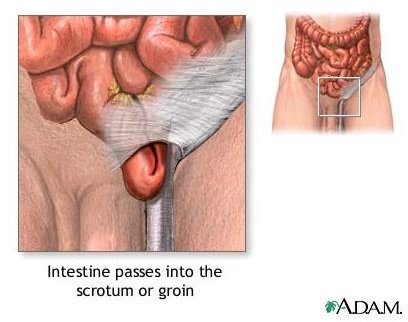Inguinal Hernia Surgery: Types and Complications
Inguinal Hernia
An inguinal hernia occurs when tissue (part of the small intestine or intra-abdominal fat) pushes through a weak area in the groin muscle (between the abdomen and thigh). This type of hernia can occur at any age and is significantly more common in males than females.
Inguinal hernia surgery is the only way to correct the problem (they do not go away on their own). If the hernia in an adult is small and painless, surgery may not be needed but the person should be aware that the hernia could later become larger (requiring surgery) or the hernia can become stuck and strangulated (a life threatening complication requiring emergency surgery). Because babies and young children are at a higher risk of strangulation, surgery is almost always performed on them.
Surgery
There are two types of surgeries that are normally done on an outpatient basis. General, spinal, or local anesthesia is used.
Open Surgery
Open surgery, called herniorrhaphy, is when the surgeon makes one incision near the hernia to correct the problem. The herniated tissue is returned to the abdominal cavity (or removed) and the defect in the muscle is closed with sutures. To prevent recurrence of the hernia, the surgeon will most likely strengthen the muscle with a piece of mesh (a procedure called hernioplasty).
Laparoscopic Surgery
This type of surgery involves making 3-4 small incisions in the lower part of the abdomen to insert small instruments (including a laparoscope) to correct the problem. The laparoscope, a thin tube with a camera at the end, allows the surgeon to see inside the body (on a monitor screen). The repair is the same as with open surgery. Laparoscopic surgery may not be recommended for large, complicated hernias or for people who have had pelvic surgery.
After the Surgery
Recovery time depends on the size of the hernia, the person’s age, the person’s health, and the technique used to correct the problem. Recovery time is normally shorter in those who had laparoscopic surgery.
Complications of inguinal hernia surgery are rare but can include the following:
• Blood clots in the legs, pneumonia, heart attack, and stroke caused by general anesthesia. This is more common in older people.
• Injury to internal organs (including the intestines, bladder, kidneys, and female organs), vas deferens (the tube that transports sperm during ejaculation), blood vessels, and nerves.
• Bleeding inside the incision. If this occurs, the incision may have to be reopened to stop the bleeding.
• Wound infection. If this occurs, antibiotics are given. In some cases, a small incision (using local anesthesia) may be necessary to drain the infection.
• Painful scar. Some people may experience a sharp, tingling pain after the incision heals. This normally resolves over time.
After inguinal hernia surgery, the chances of the hernia returning is less than 3 out of 100 people.
Sources Used
https://digestive.niddk.nih.gov/ddiseases/pubs/inguinalhernia/
https://www.nlm.nih.gov/medlineplus/ency/article/007406.htm
Photo Credit
Image courtesy of the National Library of Medicine (NLM).
